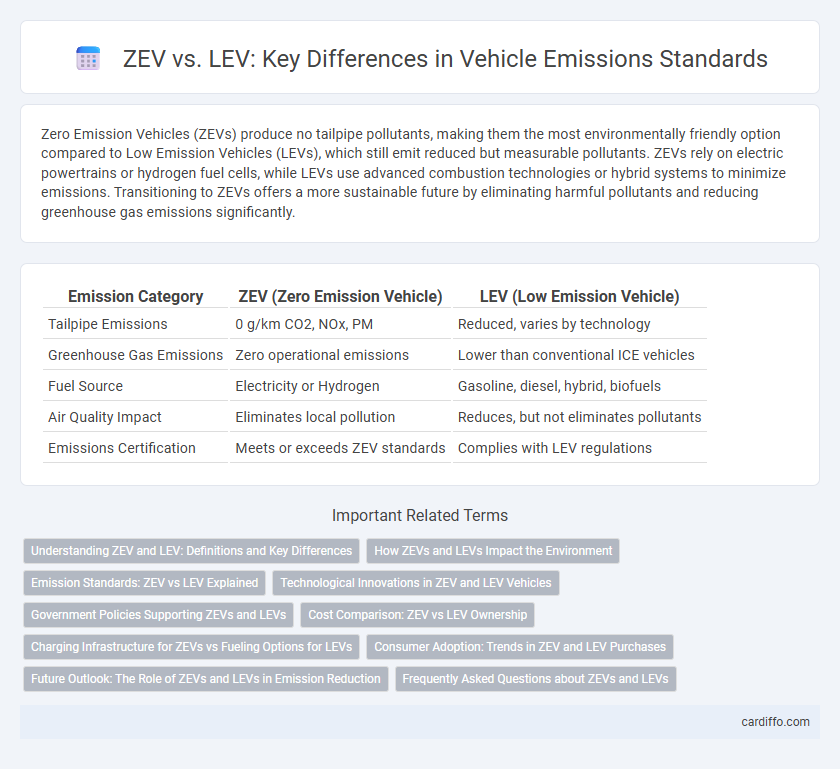Zero Emission Vehicles (ZEVs) produce no tailpipe pollutants, making them the most environmentally friendly option compared to Low Emission Vehicles (LEVs), which still emit reduced but measurable pollutants. ZEVs rely on electric powertrains or hydrogen fuel cells, while LEVs use advanced combustion technologies or hybrid systems to minimize emissions. Transitioning to ZEVs offers a more sustainable future by eliminating harmful pollutants and reducing greenhouse gas emissions significantly.
Table of Comparison
| Emission Category | ZEV (Zero Emission Vehicle) | LEV (Low Emission Vehicle) |
|---|---|---|
| Tailpipe Emissions | 0 g/km CO2, NOx, PM | Reduced, varies by technology |
| Greenhouse Gas Emissions | Zero operational emissions | Lower than conventional ICE vehicles |
| Fuel Source | Electricity or Hydrogen | Gasoline, diesel, hybrid, biofuels |
| Air Quality Impact | Eliminates local pollution | Reduces, but not eliminates pollutants |
| Emissions Certification | Meets or exceeds ZEV standards | Complies with LEV regulations |
Understanding ZEV and LEV: Definitions and Key Differences
Zero Emission Vehicles (ZEV) produce no tailpipe emissions, utilizing electric or hydrogen fuel cell technologies to eliminate pollutants such as carbon dioxide and nitrogen oxides. Low Emission Vehicles (LEV) reduce emissions through cleaner combustion engines and advanced pollution control systems but still emit some greenhouse gases and pollutants. The key difference lies in ZEVs' complete absence of direct emissions versus LEVs' partial reduction, making ZEVs critical for achieving stringent air quality and climate goals.
How ZEVs and LEVs Impact the Environment
Zero Emission Vehicles (ZEVs) produce no tailpipe emissions, significantly reducing air pollutants such as nitrogen oxides (NOx) and particulate matter, which contribute to smog and respiratory problems. Low Emission Vehicles (LEVs) emit fewer pollutants compared to traditional combustion engines by utilizing cleaner fuels or advanced technology, thereby decreasing greenhouse gases and improving urban air quality. Widespread adoption of ZEVs and LEVs plays a critical role in mitigating climate change and promoting sustainable transportation.
Emission Standards: ZEV vs LEV Explained
Zero Emission Vehicles (ZEVs) produce no tailpipe pollutants, meeting the strictest emission standards by emitting zero carbon dioxide, nitrogen oxides, or particulate matter. Low Emission Vehicles (LEVs) comply with regulatory limits that allow minimal emissions, significantly reducing but not eliminating pollutants compared to conventional vehicles. Regulatory agencies like the California Air Resources Board (CARB) enforce these standards to improve air quality and reduce greenhouse gas emissions in transportation.
Technological Innovations in ZEV and LEV Vehicles
Zero Emission Vehicles (ZEV) utilize advanced battery technologies and hydrogen fuel cells to eliminate tailpipe emissions, significantly reducing greenhouse gases and air pollutants compared to Low Emission Vehicles (LEV). LEVs incorporate improved internal combustion engines, hybrid systems, and enhanced catalytic converters to reduce pollutants while maintaining conventional fuel usage. Breakthroughs in energy storage, electric drivetrains, and regenerative braking in ZEVs enhance efficiency and sustainability beyond the incremental emission reductions achieved by LEV technologies.
Government Policies Supporting ZEVs and LEVs
Government policies promote Zero Emission Vehicles (ZEVs) through incentives like tax credits, subsidies, and stringent emission standards to accelerate adoption and reduce greenhouse gas emissions. Low Emission Vehicles (LEVs) benefit from regulations mandating lower tailpipe pollutants, encouraging manufacturers to improve fuel efficiency and integrate hybrid technologies. These policies drive market transformation by aligning automotive innovation with environmental goals, fostering cleaner transportation options.
Cost Comparison: ZEV vs LEV Ownership
Zero Emission Vehicles (ZEVs) typically incur higher upfront costs than Low Emission Vehicles (LEVs) due to advanced battery technology and limited production scale. However, ZEV owners benefit from lower operating expenses, including reduced fuel and maintenance costs, resulting in potential long-term savings. Tax incentives, government rebates, and lower environmental fees further enhance the cost-effectiveness of ZEV ownership compared to LEVs.
Charging Infrastructure for ZEVs vs Fueling Options for LEVs
Charging infrastructure for zero-emission vehicles (ZEVs) includes widespread electric vehicle (EV) charging stations such as Level 2 chargers and fast DC fast chargers, which enable efficient energy replenishment and support longer driving ranges. Low-emission vehicles (LEVs) rely on traditional fueling options like gasoline and diesel stations, with some hybrids using plug-in charging in addition to combustion fueling, but they lack the seamless integration seen in dedicated electric charging networks. The expansion of EV charging infrastructure is critical to accelerating ZEV adoption and reducing overall transportation emissions by providing convenient, accessible energy sources.
Consumer Adoption: Trends in ZEV and LEV Purchases
Consumer adoption of Zero Emission Vehicles (ZEVs) is rapidly increasing, driven by government incentives, expanding charging infrastructure, and heightened environmental awareness. Low Emission Vehicles (LEVs) continue to attract buyers seeking transitional solutions with fewer emissions than traditional internal combustion engines. Market data reveals a growing preference for ZEVs in urban areas, while LEVs maintain moderate sales in regions with limited ZEV support.
Future Outlook: The Role of ZEVs and LEVs in Emission Reduction
Zero Emission Vehicles (ZEVs), including battery electric and hydrogen fuel cell cars, are projected to play a pivotal role in achieving stringent future emission targets by eliminating tailpipe pollutants entirely. Low Emission Vehicles (LEVs), such as hybrid and advanced combustion-engine models, contribute to transitional emission reductions by improving fuel efficiency and lowering greenhouse gases. The synergy of widespread ZEV adoption alongside enhanced LEV technologies is critical for meeting global climate goals and accelerating the shift to cleaner transportation ecosystems.
Frequently Asked Questions about ZEVs and LEVs
Zero Emission Vehicles (ZEVs) produce no tailpipe emissions, relying primarily on electric batteries or hydrogen fuel cells, contrasting with Low Emission Vehicles (LEVs) that emit significantly reduced pollutants compared to conventional combustion engines. Common questions about ZEVs include inquiries on driving range, charging infrastructure, and total cost of ownership, while LEV FAQs often focus on emission standards compliance and fuel efficiency. Understanding the distinctions between ZEVs and LEVs helps consumers and policymakers make informed decisions aimed at reducing transportation-related air pollution and greenhouse gas emissions.
ZEV vs LEV Infographic

 cardiffo.com
cardiffo.com